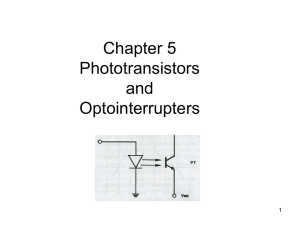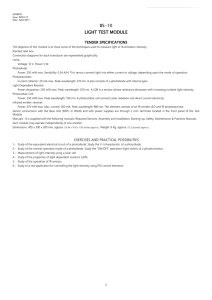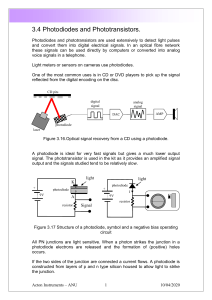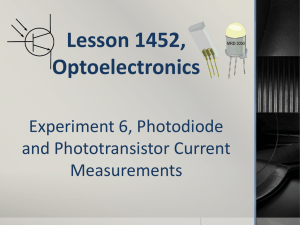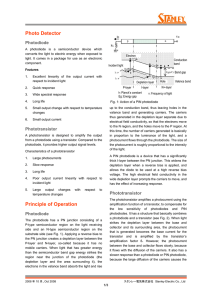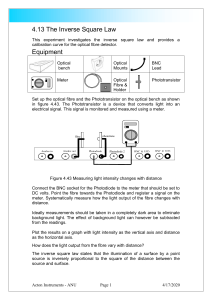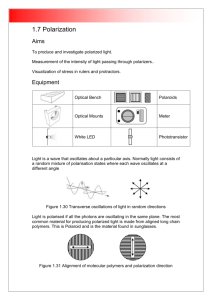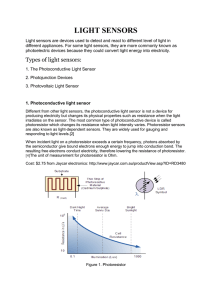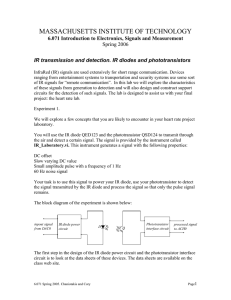Lesson 1452, Optoelectronics - Cleveland Institute of Electronics
advertisement
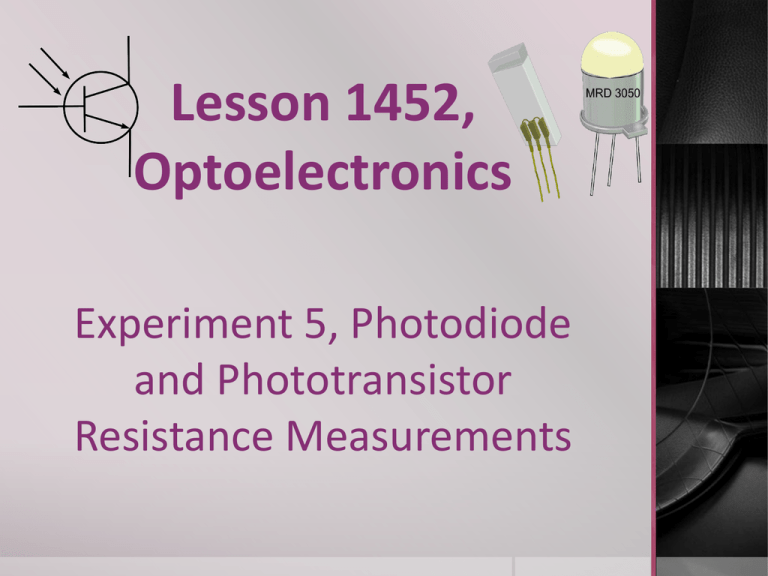
Lesson 1452, Optoelectronics Experiment 5, Photodiode and Phototransistor Resistance Measurements Objectives To show the resistance of a photodiode varies as the light intensity varies To show the resistance of a phototransistor varies as the light intensity varies Introduction A photodiode is a special diode whose resistance varies with light. It behaves much like the CdS cell you studied earlier Unlike CdS cells; photodiodes show many of the characteristics of ordinary diodes. Photo diodes have P-N junctions The main difference between the two is that no current flows through the photodiode when it is in complete darkness The photodiode also responds to changes in light intensity very quickly An external voltage source must be connected to the photodiode, since it is a passive device Any current flowing through the device will increase as the light increases because the resistance of the photodiode decreases Photodiode Symbol The two arrows pointing toward the P/N junction indicate the device responds to changes in light. If we connect a meter in series with the diode as shown in the following slide, the diode will be reversed biased. As a result, the meter will indicate when the resistance changes. Equivalent Ckt for Resistance Measurements Note that the meter is connected so that its internal battery reverse-biases the device. If the meter leads were reversed, the diode would be forward-biased. This would cause an excessive current to flow, probably damaging the device. Some disadvantages of using a photodiode will be discussed on the next slide. Disadvantages of using a Photodiode No amplification of the control current takes place As a result, the amount of current that can be used in a given circuit is limited by the amount of current the device can handle As a result, low-level control signals are of little use when using such photodiodes Phototransistors A Phototransistor is actually a device that has a conventional transistor combined in the same package with a photodiode. Below is the schematic symbol Phototransistor Equivalent Circuit Functionally, the phototransistor is very similar to the light-meter circuit we built and discussed previously As the photodiode resistance decreases, the base current of the transistor increases, and the collector current increases accordingly If an Ohmmeter were connected across the emitter and collector, it would see a decrease in resistance as the current increased. Though, this is impossible to measure. Procedure: Now you will measure photodiode and phototransistor resistances The photodiode measurements will be made between the base and collector terminals of the phototransistor The phototransistor measurements will be made between the collector and emitter terminals of the phototransistor 1. Locate the phototransistor a) The phototransistor is very similar to a normal transistor, except for the plastic lens on the top of the transistor 2. Mount the photo transistor on the breadboard. a) Use posts for measurements or carefully spread the leads of the transistor apart to allow you to connect your meter leads 3. Note the lead configuration as seen from the bottom of the transistors 4. Switch your meter to X 1000 Resistance range and connect the meter to the transistor as shown in next slide a) Note: We have assumed the positive lead of the battery is connected to the Black meter lead. (Reverse the meter connections if your battery is connected the opposite way!) 5. Temporarily place a piece of black electrical tape over the lens of the transistor a) Switch meter to the best range and measure the resistance b) Record the reading in the data table; an example of the table is shown on the slide following the schematic Photodiode Measurements Schematic Photodiode Pictorial Photodiode Pictorial 6. Remove the tape from the lens and place the device about three feet from a 60W lamp 7. Move the lamp closer and farther from the transistor. Notice if the resistance of the photodiode increases or decreases. 8. Change the meter lead connections to agree with the following schematic 9. Temporarily place a piece of black electrical tape over the lens of the transistor. Record the resistance 10. Remove the tape from the lens and place the device about three feet from a 60W lamp. Record the resistance Phototransistor Measurements Schematic Phototransistor Pictorial Phototransistor Pictorial 11. Vary the distance between the lamp and the phototransistor. a) As the lamp distance decreases, do you expect the resistance of the phototransistor to increase or decrease? Why do you expect this? You should have seen a trend of decreasing resistance with increasing light. Final Discussion You measured the resistance of both the photodiode and phototransistor. You should have seen the resistance decreased as the light increased with both devices. You probably measured different resistance values, for the two devices, with the same light conditions A phototransistor consists of a photodiode connected between the base and the collector of the transistor You were able to make your photodiode measurements by measuring between the base and collector leads of the transistor You were also able to make your phototransistor measurements by measuring between the collector and emitter leads of the transistor In most applications, phototransistors are used in this way, only using the two leads (Collector and Emitter) connected to the circuit. Questions? Resources Rosenow. (2001). Lesson 1452: Optoelectronics. Cleveland: Cleveland Institute of Electronics. The End Developed and Produced by the Instructors in the CIE Instruction Department. © Copyright 06/2012 All Rights Reserved / June 2012
